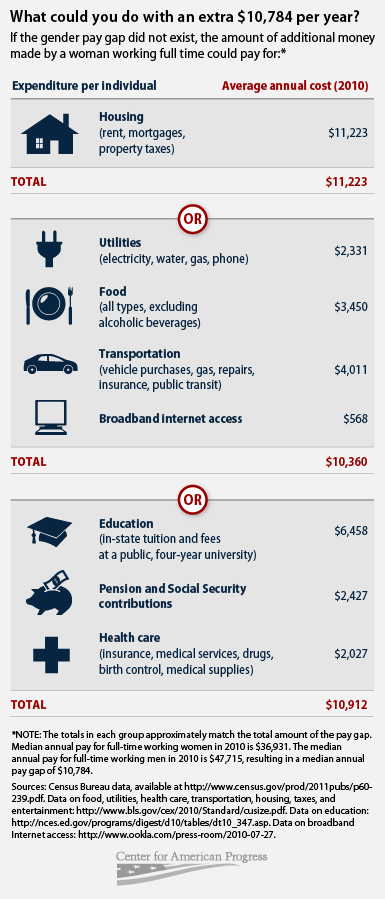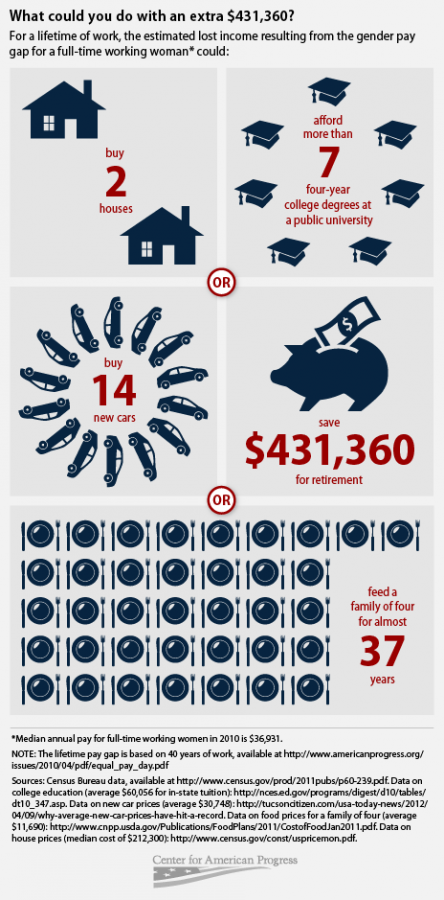While income inequality between the sexes has decreased in recent decades, women still only make seventy-seven cents for every dollar a man is paid. Matt Separa from the Center for American Progress illustrated what could be bought with those lost wages to help us conceptualize how wide the wage gap is.
His first chart shows how the $10,784 in underpaid wages would almost cover annual housing costs or could pay the combined costs of a year’s worth of utilities, food, transportation, and internet access with a few hundred dollars to spare. The lost wages could also almost pay all the expenses for annual in-state tuition at a public university, twelve months of contributions to Social Security, and basic medical care for a year:
His second chart illustrates how across a lifetime, the lost wages ($431,360) could buy two houses, seven degrees from public universities, fourteen cars, or pay for a family of four to eat for thirty-seven years. Many of Spera’s examples, including real estate, tuition and retirement savings, are especially powerful because they show how the lost wages could be turned into capital and wealth that would pay even more dividends on top of the lost income:
Overall, the graphs do a nice job of making the implications of the gender wage gap concrete.
—————
Jason Eastman is an Assistant Professor of Sociology at Coastal Carolina University who researches how culture and identity influence social inequalities.



Comments 26
Xiao Mao — May 26, 2012
Great post, with numbers you can chew on. Maybe some day the naysayers/MRAs/librul d00ds will stop trying to deny what is a sucky reality for me and most women.
Legolewdite — May 26, 2012
*Patriarchy hurts men as well as women, limiting the choices of each. I mention this not trivialize women's lower class status - to be sure women have it worse! But I think in the interest of progressive change it's important to realize that men should fight sexism as well, not for any sense of chivalrous altruism, but for there own liberation as well.
Theodore Vaughn — May 26, 2012
So are women angry about this or happy for this? Technically this helps women as a whole. Who do you think an employer would rather higher, 1 expensive guy, or 2 cheaper women?
This pay gap is probably contributing to the massive education gap/skills gap between the genders. There is just more waiting for a woman post graduation due to their lower pay when compared to a guy.
pduggie — May 26, 2012
Also, think how much money companies could save if they fired all male workers and hired only females at prevailing female wages. They'd make a fortune.
I wonder why they don't?
sunandmoon1 — May 26, 2012
Wish this information was available in terms of transgender v. cisgender wage differences.
decius — May 26, 2012
Interesting. Where did you find the total earnings of women and the total earnings of men, excluding fringe benefits?
Considering that women make up 46% percent of the workforce, earning 43.5% of the total wages seems within normal statistical variation.
Or did you throw out a number as 'statistical fact' but only loosely specify what statistic you were reporting?
The DOL report (PDF) concurs in part but dissents overall: While it doesn't think to oversimplify and compare the median woman to the median man, it does try to account for things like the hourly wage of salaried employees who work more than the default 2000 hours in a year, as well as the value of nonwage benefits.
From section 2.2.2:
When earnings are measured by the index of total compensation, the average value of the index for females is 96.4 percent of the average value for males."
Vbowen — May 28, 2012
My students don't believe that a gender gap still exists (there high school and like to believe the world has ironed out such injustices). Great visual showing them how much money men make over women. Thanks for the classroom help.
How Much more Money Are Men Making Over Women? Let’s Visualize it Shall We « Welcome to the Doctor's Office — May 29, 2012
[...] from SocImages [...]
Rachel Krieger — May 30, 2012
These statistics horrify me. I am only 18 years old and am going to be a sophomore in college going for my nursing degree, but I can understand the value of that lost money. I work two jobs as it is and babysit almost daily and to see that when I am a nurse making more money I will actually be losing it upsets me.
First Time Reader — June 2, 2012
Am I missing something here? I'm only seeing two graphics that deal with what a gap of X amount of dollars could do for a person/family, but I'm not seeing any evidence that there is such a gap in reality... is the wrong article linked to these comments? Or am I not seeing the link to the second page?
I'm not trying to be rude here, it just really seems like I'm looking at a massive html glitch.
Ein paar Zahlen zum Gender Pay Gap | Mina. — June 20, 2012
[...] Diskriminierung und Vorurteile sprechen, aber das nur am Rande). Ich habe auf einem amerikanischen Soziologie-Blog eine tolle Darstellung zum Gender Gap gesehen und versuche das nun in schlecht und nicht so schön [...]
[image] Illustrating the Gender Pay Gap | slendermeans — July 30, 2012
[...] Illustrating the Gender Pay Gap. While income inequality between the sexes has decreased in recent decades, women still only make [...]
The Growing Gap: Which Average Are We Talking About? « Unladylike Musings — September 27, 2012
[...] I hear the word “gap” in relation to women my first thought is the gender pay gap between men and women. But there is another gap we should be worrying about, the growing gap between the average sized [...]
Ein paar Zahlen zum Gender Pay Gap | Frau Dingens — December 30, 2012
[...] Diskriminierung und Vorurteile sprechen, aber das nur am Rande). Ich habe auf einem amerikanischen Soziologie-Blog eine tolle Darstellung zum Gender Gap gesehen und versuche das nun in schlecht und nicht so schön [...]
quick hit: Illustrating the Gender Pay Gap | feimineach — December 30, 2013
[…] [Read more: sociologicalimages] […]
I'm a cop. If you don't want to get hurt, don't challenge me. - Page 2 - PeachParts Mercedes ShopForum — August 22, 2014
[…] rather not be raped by cops and to be ticketed instead of that and instead of being leered at, especially if we had as much money as men to pay the tickets. Imagine that, being paid less and being sexually assaulted and harassed by people meant to protect […]